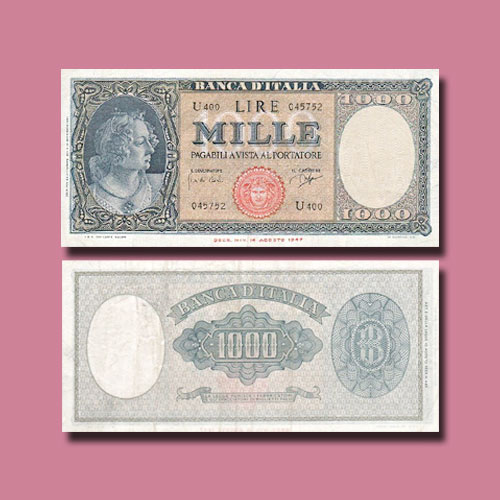Italy 1000 Lire banknote of 1948-1961
2019-06-06 Thu
Italy is a European country with a long Mediterranean coastline. This country has left a powerful mark on Western culture and cuisine. Its capital, Rome, is home to the Vatican as well as landmark art and ancient ruins. Other major cities include Florence, with Renaissance masterpieces such as Michelangelo’s "David" and Brunelleschi's Duomo; Venice, the city of canals; and Milan, Italy’s fashion capital.Due to its central geographic location in Europe and the Mediterranean, Italy has historically been home to a myriad of peoples and cultures. Italy has a major advanced capitalist mixed economy, ranking as the third-largest in the Eurozone and the eighth-largest in the world. Italy is the world's sixth largest manufacturing country.
The lira (plural “lire”) was the currency of the country during various intervals of its history. From the Napoleonic Kingdom of Italy between 1807 and 1814, the Albanian Kingdom between 1941 and 1943 to the introduction of the Euro, Lira was the official currency of Italy. It was subdivided into 100 centesimi.
Today we are discussing a 1000 Lire banknote that was issued from 1948-61. The obverse depicts a female profile taken from the group of "Three Graces" in Botticelli's "Spring" that is housed in the Uffizi Gallery in Florence. The reverse depicts the Bank Seal - head of Medusa.
Image Courtesy: www.ma-shops.com
Latest News
-
Malwa Sultan Mahmud Shah Silver Coins
2025-09-11 ThuMalwa Sultan Mahmud Shah minted silver coins in round and square flans. <br><br> For round coins,...
-
Malwa Sultan Mahmud Shah Billon coin
2025-08-26 TueMalwa Sultan Mahmud Shah's billon coins followed three weight standards: 100 rati, 96 rati, and 80 r...
-
Fascinating Archaeological Facts on Postage Stamps - 91
2025-08-23 SatRhinoceros is one of the oldest land mammal species existing in India. There are five species of rhi...
-
Fascinating Archaeological Facts on Postage Stamps - 90
2025-08-23 SatUthiramerur, a Village in Kanchipuram, Tamil Nadu, is notable for its Temple inscriptions that descr...
-
Fascinating Archaeological Facts on Postage Stamps - 89
2025-08-21 ThuThe term “millet” is derived from the Latin word “milum,” which translates to grain. millets...

